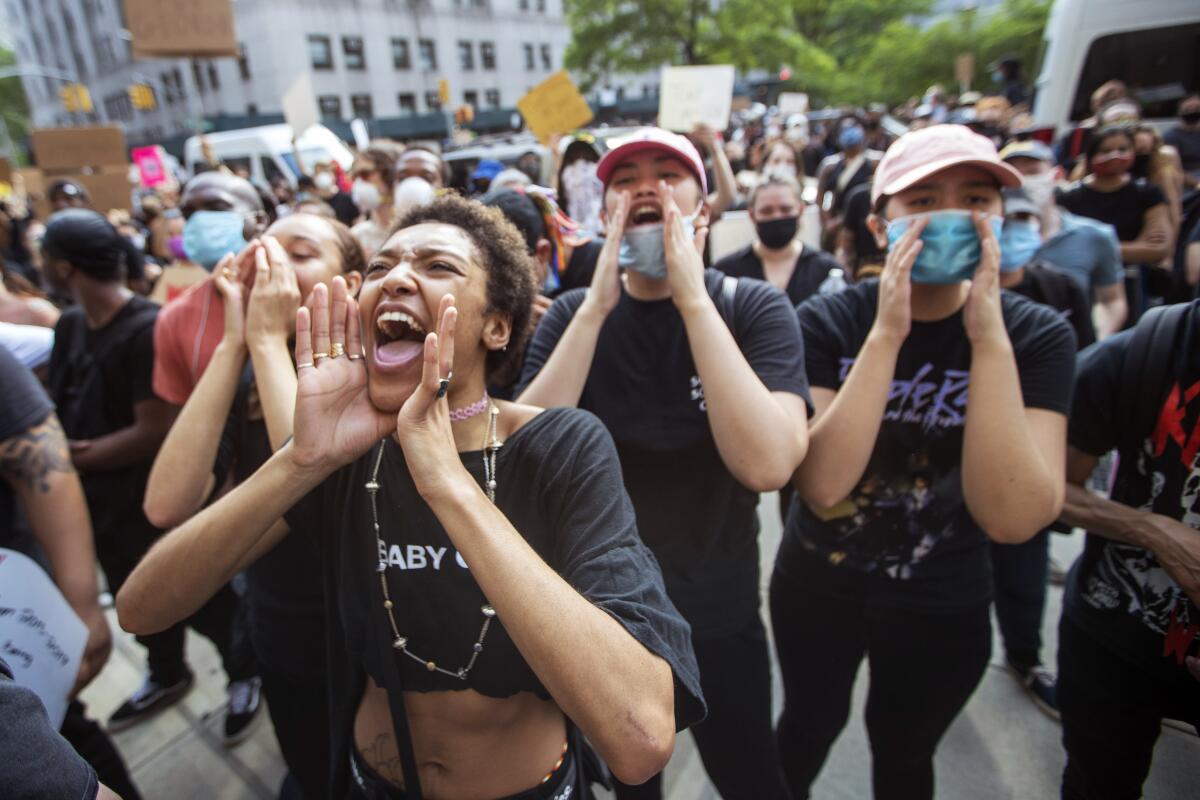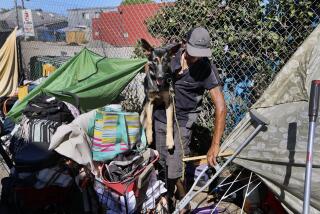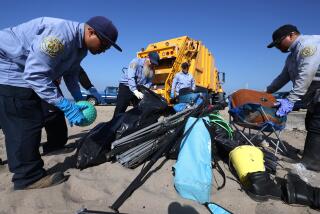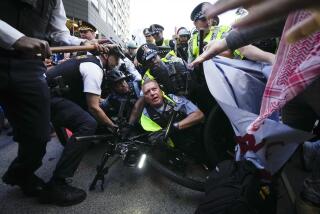Police in riot gear clear New York’s ‘Occupy City Hall’ camp

- Share via
NEW YORK — Police in riot gear raided an encampment of protesters and homeless people near New York’s City Hall before dawn Wednesday, clearing out the camp that formed a month ago to push for budget cuts and other changes to the nation’s largest police department.
A line of New York Police Department officers with helmets and shields entered City Hall Park shortly before 4 a.m. and forced out what officials said were about 50 people, many of them homeless, who remained at the encampment. Mayor Bill de Blasio said the move was unrelated to President Trump’s threats to send federal law enforcers to New York to take on protesters, as the Republican president has done in Portland, Ore.
“We do always respect the right to protest, but we have to think about health and safety first, and the health and safety issues were growing,” said De Blasio, a Democrat. “So it was time to take action.”
Speaking later in Albany, Democratic Gov. Andrew Cuomo said Trump told him by phone that he wouldn’t deploy extra federal law enforcement forces to New York for now, and that the two leaders would speak before any such action happened.
Video from the police raid at City Hall Park shows officers moving through the camp, taking down tents and other temporary structures and tossing them into garbage trucks to be hauled away. Cleaning crews arrived later to scrub graffiti from buildings in the area.
Police Commissioner Dermot Shea said officers instructed people to leave, let them do so and many did, but about six were given summonses for refusing to disperse. One person was arrested for throwing a brick at an officer, denting his shield, Shea said. The commissioner said that no injuries were reported and that there was “no real use of force,” though he said there was “some tugging and back and forth.” He called the episode “one for the win column ... another step towards getting back to normalcy here in New York.”
An iconic image has emerged on Twitter since early Saturday morning in Portland, when a woman wearing nothing but a mask and cap strode toward federal agents as they fired tear gas at protesters — a surreal image of human vulnerability in the face of an overpowering force.
But some protesters disputed Shea’s account, saying they didn’t hear a warning before police poured in, threw people’s possessions away and pushed them around.
“They tried to run us over with bikes,” Nene Thompkins, a 19-year-old woman living at the camp told Gothamist. “They pushed us with shields. They told us we couldn’t be on the sidewalk so walk on the street, then as soon as we got on the street they ambushed us.”
De Blasio said shelter services were offered to homeless people at the encampment.
The encampment, sometimes called “Occupy City Hall” or “Abolition Plaza,” started in late June with several hundred people following weeks of protests sparked by the May death of George Floyd at the hands of Minneapolis police. The New York camp was part of a national “defund the police” movement seeking to redirect funds from policing to community needs like housing and education.
Protesters said they would camp out until the city reduced the New York Police Department’s budget by $1 billion. The City Council responded by passing a budget that shifts roughly $1 billion from the Police Department, but some activists criticized the funding cuts as cosmetic or insufficient.
De Blasio had earlier resisted calls to move the protesters.
The encampment was reminiscent of 2011’s Occupy Wall Street, when protesters against income inequality took over Zuccotti Park, a few blocks from City Hall. Police removed them after two months. De Blasio, who was then the city’s elected public advocate, criticized then-mayor Mike Bloomberg’s deployment of police to clear Occupy Wall Street.
De Blasio said Wednesday’s raid was different, drawing a distinction between Occupy Wall Street as “a protest situation” and the City Hall Park camp, which he characterized as having become “less and less about protests” and more a homeless camp where “health and safety issues came to the fore.”
People involved in the camp have said it served in part to demonstrate that the city was failing the homeless.
More to Read
Sign up for Essential California
The most important California stories and recommendations in your inbox every morning.
You may occasionally receive promotional content from the Los Angeles Times.










